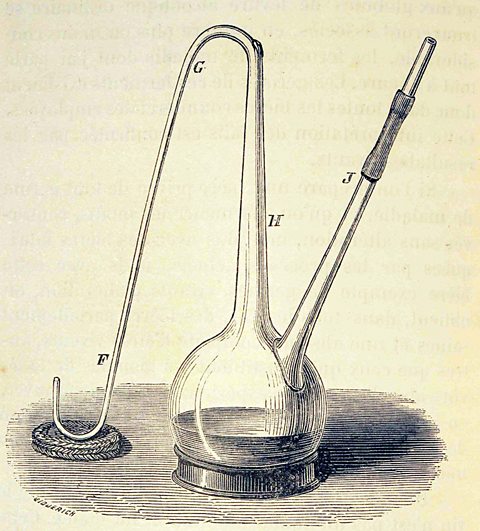The fight against disease
Watch to recap the work of Pasteur and Koch before finding out more about their work.
Up to the 1860s, beliefs about the causes of disease were still based on ancient ideas, such as miasmaSmells from decomposing material, such as animal and human waste, that were thought to cause disease. Louis PasteurвҖҷs discovery of germ theory would revolutionise medicine.
Spontaneous generation
Doctors were aware that germs existed in the late 17th century. However, there was not a belief that germs caused disease. People believed in spontaneous generation The theory, now proven to be incorrect, that living organisms could develop from non-living matter. This led to the belief that germs, which appeared at the site of disease or illness, were a consequence of the illness rather than the cause of the illness.
What did Louis Pasteur do?

Louis Pasteur was a French chemist. In the 1850s, he was asked by a French winemaker to investigate why their wine was going off. Pasteur used a microscopeA device used to enlarge tiny objects that cannot be seen by the naked eye. to see that there were bacteriaSingle-celled microorganisms, some of which are pathogenic in humans, animals and plants. Singular is bacterium. a type of microbeMicroscopically small organism, such as a bacterium or single-celled fungus. Also called a microorganism. in the wine. He believed this was what was making it go off. He successfully heated the wine to kill the bacteria.
Pasteur carried out further experiments to prove his theory. He put some broth in two swan neck flasks and boiled it, which killed any microbes that were already there. He then broke the neck off one of the flasks. The flask that was exposed to the air went bad, but the sealed flask did not. This further proved PasteurвҖҷs theory that microbes were in the air and caused disease in humans.
In 1861 Pasteur published his work on germ theory. This was a hugely significant moment. It allowed further advances to take place in vaccineA substance that stimulates the body to produce antibodies to provide immunity against a disease. surgery and antibioticsSubstances that control the spread of bacteria in the body by killing them or stopping them reproducing.
What did Robert Koch do?
Robert Koch was a German doctor. He used industrial dyes to stain bacteria. This made them easier to identify when viewed under a microscope. In 1876, he identified the germ that causes anthrax. This was the first time the bacteria responsible for a specific disease had been identified. Identifying specific bacteria was crucial in being able to develop effective treatments and vaccines.
Pasteur and Koch were rivals, but their work led to significant advances in medicine.
The chicken cholera vaccine
In 1879, Pasteur was working with his assistant, Charles Chamberland, to try to find a cure for chicken cholera. They were injecting chickens with cholera germs and then trying to cure them.
On returning from holiday, Chamberland injected a chicken with cholera germs. It did not become ill. Pasteur told Chamberland to try again with fresh germs but the chicken still did not become ill. Pasteur realised that the old germs had caused the chicken to develop immunityWhen a person's body is not prone to a disease because they have a resistance to it. to cholera. This meant that he and Chamberland had discovered a vaccine by chance.
This would lead to further vaccines quickly being discovered (eg for anthrax and rabiesA viral disease that affects the central nervous system.). Unlike Jenner, Pasteur understood why his vaccine had worked, so he could replicate the process for other diseases.
How did the fight against disease develop?
Which factors helped Pasteur and Koch?
Pasteur and Koch were helped by various factors:
- Technology - KochвҖҷs assistant, Julius Richard Petri, invented the Petri dishA clear glass or plastic dish, used to grow living cells from organisms so they can be studied. This enabled Koch to grow bacteria. He could then use industrial dyes to stain the bacteria. Finally, he could use powerful microscopes to identify the bacteria.
- Chance - Pasteur developed the chicken cholera vaccine when he left some cholera germs unrefrigerated before going on holiday. When his assistant, Charles Chamberland, injected these germs into a chicken on their return, the chicken did not become ill. Pasteur realised that the old germs had given the chicken immunity without making it ill.
- War - In 1870-1871, France and Germany were fighting each other in the Franco-Prussian War. This led to rivalry between Pasteur and Koch. Their respective governments invested in their research to show they had more advanced science and for national pride.
- Key individuals - Pasteur and Koch are both significant figures in the fight against disease. Their work relied on careful observation, scientific experiments, and years of work to develop new methods and treatments.